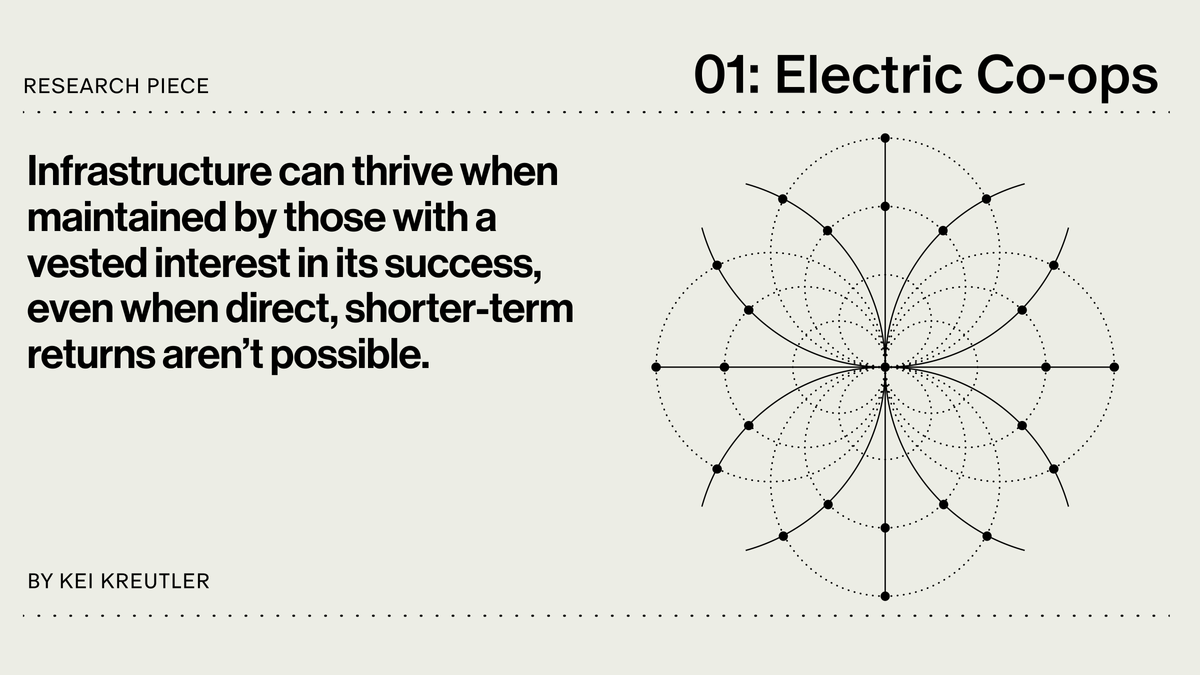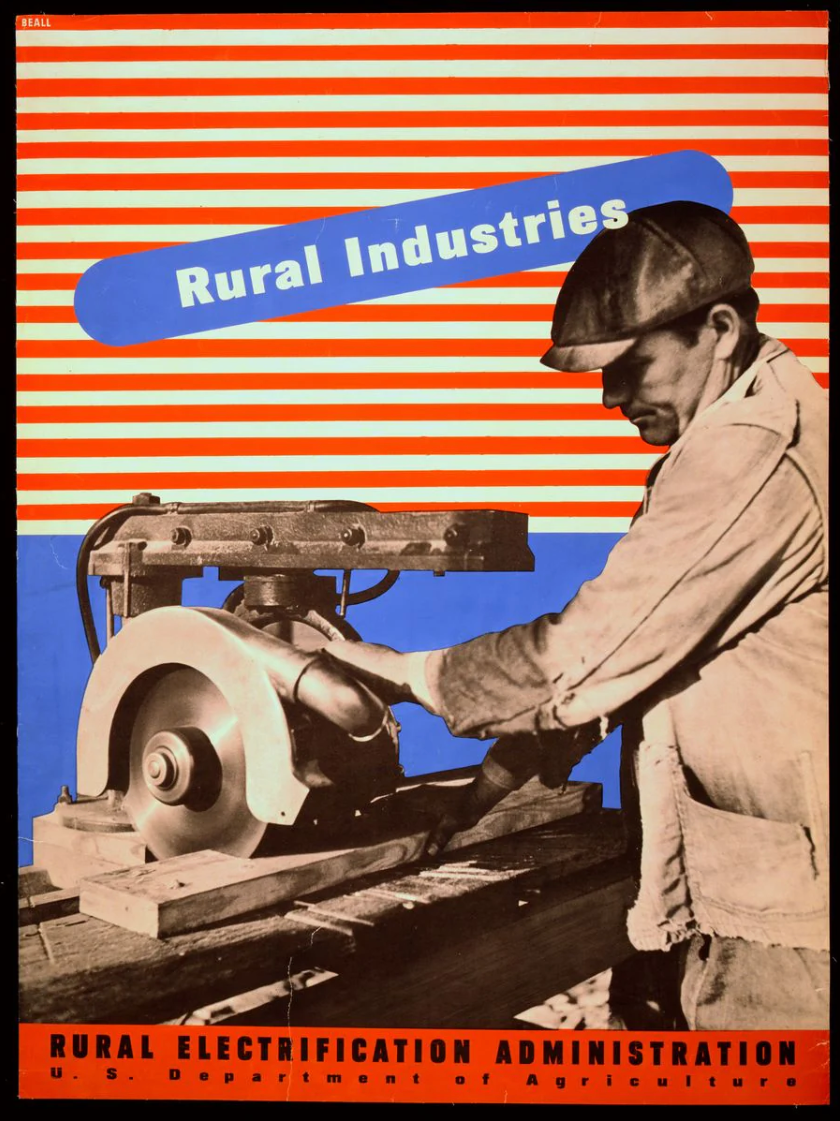Research Piece: Electric Cooperatives
In 1929, just 13% of rural homes had electricity. By 1944, it was 94%. How? "Electric cooperatives" owned the infrastructure they built. But today, blockchains with programmable sequencers can make any piece of infrastructure community owned and controlled.

This series shares brief case studies of organizations relevant for designing economic mechanisms around ownership of decentralized infrastructure. I intend these posts to be informative, rather than copy-paste recommendations, so I present advantages, disadvantages, and speculations around each model that I learned through my recent research.
Written by Kei Kreutler.
Infrastructure is what you don't notice until it stops working.
I remember this saying going around frequently in the 2010s when there was a concerted effort to center infrastructure in public discussion. Maybe this effort was successful, or maybe things stopped working more often, but either way, the need to bring infrastructure to the foreground seems clearer now.
Our infrastructure relies on electricity. Many wouldn't be able to access drinking water from their taps without it. Vehicles won't run without it soon. For something so central, it's hard to believe widespread access to it is less than a century old.
This puts into context the ambitions of many blockchain projects to become global infrastructure, providing services for decentralized notaries, assets, and information storage that most people in the world could access. Legitimating this public use at scale isn't guaranteed.
For this brief case study, I look at how existing infrastructure became publicly accessible in a specific context, namely how the American electric cooperative network grew.
The Mutualist History of U.S. Electric Cooperatives
By the 1920s, urban America had been electrified. 90% of urban homes had electricity supplied through investor-owned utility companies that constructed power plants. While it made economic sense to provide services to densely populated urban areas, constructing the infrastructure necessary to electrify rural America did not. By contrast, only 10% of rural homes had electricity at this time.

Electricity had the power to reshape rural industry, but it couldn't, yet. This began to change in 1936 with the Rural Electrification Act (REA). The policy initially proposed providing loans to private utility companies to build electrical distribution systems in rural areas, but the upfront costs plus the ongoing maintenance costs still proved unprofitable. So rather than provide subsidies, the REA instead offered low interest loans specifically to cooperatives, for two core reasons. One, farmers in rural areas were familiar with the cooperative organizational structure, and two, local residents and businesses were more likely to invest, maintain, and benefit directly from electrification in ways that large private utility companies would not.
This led to the formation of many cooperatives throughout the country, some of which are still operating today, like the North Arkansas Electric Cooperative, the Blue Ridge Electric Membership Corporation, and more that have morphed into broader cooperative associations.
While undoubtedly challenges arose around contracting the expertise required to build electrical distribution systems in these areas, these difficulties were overcome. The REA proved successful. While only 13% of rural homes had electricity in 1929, by 1944, just 15 years later amidst economic depression and a world war, 94% of rural homes had electricity. Today, 900 electric cooperatives still provide 12% of Americans with power, and now they lead the effort to bring fiber optic internet to rural areas.[1]

Their endurance is linked to a key feature of the REA. The loans didn’t only provide financing for building electrical distribution systems, they also conferred ownership of the equipment to the cooperative that took on the loan. This meant that, once paid, all electric cooperatives actually owned the infrastructure they built, enabling the cooperative to benefit from it in perpetuity as a mutualist organization.
Electric Cooperatives' Relevance for Today
The REA's success hinged on a fundamental insight: infrastructure can thrive when maintained by those with a vested interest in its success, even when direct, shorter term returns aren’t possible. Local cooperatives were better positioned to bring electricity to their rural areas, because the long term benefit to their businesses, communities, and families outweighed the upfront opportunity costs.
This approach yielded two powerful secondary benefits. First, it created technical expertise in rural communities, broadening a new class of skilled workers in electrical distribution systems over time. Second, it established a path to wealth building through infrastructure ownership, as communities gained both practical knowledge and valuable capital assets.
Learnings and Examples
In today's blockchain landscape, many layer 2 networks face a challenge related to encouraging developers to build on and extend their infrastructure. The electric cooperative model suggests an interesting parallel approach.
Example Scenario
Consider an example L3 network called Electricity. In this model, 3% of all sequencer fees would flow into an Electricity Co-Op Pool, creating a sustainable funding source for infrastructure development. Projects seeking to build infrastructure services, deployments, or applications in the ecosystem could access low-interest loans from this pool, mirroring the REA’s approach.
// SPDX-License-Identifier: UNLICENSED
pragma solidity 0.8.25;
import {IsAllowed} from "src/interfaces/IsAllowed.sol";
/**
* @title ElectricCoopSequencing
* @dev Validates sequencer membership and collects cooperative fees
*/
contract ElectricCoopSequencing is IsAllowed {
uint256 public constant COOP_FEE_BPS = 300; // 3%
address public immutable coopPool;
mapping(address => bool) public isMember;
function isAllowed(address proposer) external view override returns (bool) {
require(isMember[proposer], "Must be contributing fees to the cooperative");
return true;
}
function collectFees() external payable {
uint256 coopFee = (msg.value * COOP_FEE_BPS) / 10000;
Sequencers would contribute to the ecosystem's growth through their fees, and projects would be able to take on low interest debt financing while building an infrastructure service in which they retain full ownership, not forfeiting governance, economic, or influential power to potentially misaligned investors.
Over time, this builds a network of committed "local" contributors, each one adding infrastructure that strengthens the entire Electricity ecosystem.
[1] Feygin and Gilman, “The Mutualist Economy: A New Deal for Ownership.”
Sources
“About NAEC - North Arkansas Electric Cooperative.” Accessed January 12, 2025.
Feygin, Yakov and Nils Gilman. “The Mutualist Economy: A New Deal for Ownership.” Berggruen Institute. April 23, 2020.
“Records of the Rural Electrification Administration [REA].” Accessed January 12, 2025.